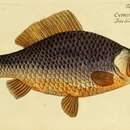Diagnostic Description
provided by Fishbase
Diagnosed from its congeners in Europe by having the following characters: body silvery-brown in color; last simple anal and dorsal rays strongly serrated; 37-52 gill rakers; lateral line with 29-33 scales; freed edge of dorsal concave or straight; anal fin with 5½ branched rays; and peritoneum black (Ref. 59043).
Diseases and Parasites
provided by Fishbase
Black Spot Disease 1. Parasitic infestations (protozoa, worms, etc.)
Diseases and Parasites
provided by Fishbase
Thelohanellus Infection 4. Parasitic infestations (protozoa, worms, etc.)
Life Cycle
provided by Fishbase
Females spawn with several other species, for example Cyprinus carpio and Carassius carassius, but the eggs just develop without being actually fertilized resulting in a female only population (Ref. 2059). In Europe, populations considered as triploid and only females. But in some populations, it should be possible to find up to 25% of males which should be diploid (Ref. 40476). "There are also all-female populations in which all individuals are triploids. Triploids are sperm parasites of other cyprinid species such as Cyprinus carpio, Rutilus rutilus and Abramis brama. Older individuals spawn earlier in season than younger ones. Males move to spawning sites before females. Males follow ripe females, often with much splashing. Sticky eggs are attached to water plants or submerged objects" (Ref. 59043).
Migration
provided by Fishbase
Potamodromous. Migrating within streams, migratory in rivers, e.g. Saliminus, Moxostoma, Labeo. Migrations should be cyclical and predictable and cover more than 100 km.
Biology
provided by Fishbase
Inhabits a wide variety of still water bodies and lowland rivers, usually associated with submerged vegetation or regular flooding. Can strongly tolerate low oxygen concentrations and pollution (Ref. 59043). Lake dwelling individuals move into river mouths to avoid low oxygen water in winter (Ref. 39176). Feeding larvae and juveniles occur in high-complexity habitats as reed belts. Feeds on plankton, benthic invertebrates, plant material and detritus. Spawns in shallow, warm shores on submerged vegetation (Ref. 59043). Able to reproduce from unfertilized eggs (gynogenesis) (Ref. 41851). Life span reaches up to about 10 years (Ref. 59043). Eastern European or wild form of the goldfish (Ref. 1739).
Importance
provided by Fishbase
fisheries: minor commercial

